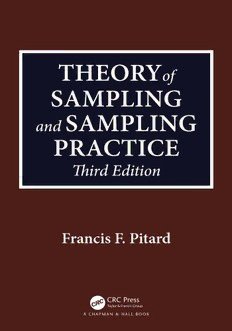Table Of ContentTheory of Sampling and
Sampling Practice
This page intentionally left blank
Theory of Sampling and
Sampling Practice
Third Edition
Edited by Francis F. Pitard
CRCPress
Taylor&FrancisGroup
6000BrokenSoundParkwayNW,Suite300
BocaRaton,FL33487-2742
©2019byTaylor&FrancisGroup,LLC
CRCPressisanimprintofTaylor&FrancisGroup,anInformabusiness
NoclaimtooriginalU.S.Governmentworks
Printedonacid-freepaper
InternationalStandardBookNumber-13:9781138476486(Hardback)
Thisbookcontainsinformationobtainedfromauthenticandhighlyregardedsources.Reasonableeffortshavebeenmadeto
publishreliabledataandinformation,buttheauthorandpublishercannotassumeresponsibilityforthevalidityofall
materialsortheconsequencesoftheiruse.Theauthorsandpublishershaveattemptedtotracethecopyrightholdersofall
materialreproducedinthispublicationandapologizetocopyrightholdersifpermissiontopublishinthisformhasnotbeen
obtained.Ifanycopyrightmaterialhasnotbeenacknowledgedpleasewriteandletusknowsowemayrectifyinanyfuture
reprint.
ExceptaspermittedunderU.S.CopyrightLaw,nopartofthisbookmaybereprinted,reproduced,transmitted,orutilizedin
anyformbyanyelectronic,mechanical,orothermeans,nowknownorhereafterinvented,includingphotocopying,
microfilming,andrecording,orinanyinformationstorageorretrievalsystem,withoutwrittenpermissionfromthe
publishers.
Forpermissiontophotocopyorusematerialelectronicallyfromthiswork,pleaseaccesswww.copyright.com(http://www.
copyright.com/)orcontacttheCopyrightClearanceCenter,Inc.(CCC),222RosewoodDrive,Danvers,MA01923,978-750-
8400.CCCisanot-for-profitorganizationthatprovideslicensesandregistrationforavarietyofusers.Fororganizationsthat
havebeengrantedaphotocopylicensebytheCCC,aseparatesystemofpaymenthasbeenarranged.
TrademarkNotice:Productorcorporatenamesmaybetrademarksorregisteredtrademarks,andareusedonlyfor
identificationandexplanationwithoutintenttoinfringe.
LibraryofCongressCataloging-in-PublicationData
Names:Pitard,FrancisF.,author.
Title:TheoryofSamplingandSamplingPractice/FrancisF.Pitard.
Othertitles:PierreGy’ssamplingtheoryandsamplingpractice
Description:Thirdedition.|BocaRaton:Taylor&Francis,2019.|Revisededitionof:PierreGy’ssamplingtheoryand
samplingpractice:heterogeneity,samplingcorrectness,andstatisticalprocesscontrol/FrancisF.Pitard.2nded.c1993.|
Includesbibliographicalreferences.
Identifiers:LCCN2018040960|ISBN9781138476486(hardback:alk.paper)|ISBN9781351105934(ebook)
Subjects:LCSH:Ores–Samplingandestimation.
Classification:LCCTN560.P562019|DDC622/.7–dc23
LCrecordavailableathttps://lccn.loc.gov/2018040960
Visit the Taylor & Francis Web site at
http://www.taylorandfrancis.com
and the CRC Press Web site at
http://www.crcpress.com
Contents
Foreword................................................................ xxvii
Preface ...................................................................xxix
TheAuthor ...............................................................xxxi
Part I Introduction and a Management Strategy . . . . . . . . . . . . . . . . 1
Introduction .....................................................1
HistoricalSummary...............................................4
SubdivisionsoftheText ...........................................7
1. DefinitionofBasicTermsandSymbols ...................................11
1.1 BasicTerms .....................................................11
1.2 ListofNotationandSymbols ......................................25
1.2.1 LatinLetters ............................................25
1.2.2 GreekLetters ...........................................26
1.3 TheWordErrorversustheWordUncertaintyControvercy..............26
1.3.1 Introduction ............................................27
1.3.2 GoingBacktoMatheronandGy’sFundamentals.............28
1.3.3 JumpingfromUncertaintytoError.........................28
1.3.4 SamplingCorrectness:TheMandatoryPathtoPredictable
Uncertainty.............................................29
2. AManagementStrategy.................................................31
2.1 StructuralProperty...............................................31
2.2 CircumstantialProperty...........................................32
2.3 ConceptsofPrimaryandSecondaryProperties.......................33
2.3.1 TheConcept ............................................33
2.3.2 TheConsequences.......................................33
2.4 ThePrimaryStructuralPropertyofSamplingCorrectness..............35
2.5 RelationshipbetweenCorrectnessandAccuracy......................35
2.6 PracticalAdvantagesofControllingSamplingCorrectness .............36
2.7 DisadvantagesandRisksofControllingAccuracy.....................36
2.8 Conclusions .....................................................37
Part II Fundamental Statistical Concepts Used in the Theory of
Sampling . . . . . . . . . . . . . . . . . . . . . . . . . . . . . . . . . . . . . . . . . . 39
3. FundamentalStatisticalConcepts.........................................41
3.1 NotionofProbability .............................................43
v
vi Contents
3.2 ProbabilityLawofaRandomVariable ..............................44
3.2.1 NotionofRandomVariable...............................44
3.2.2 FromaRandomVariabletoItsProbabilityLaw..............45
3.2.3 DefinitionofaProbabilityLaw ............................45
3.2.4 GraphicRepresentationofaProbabilityLaw
(DiscreteVariable).......................................45
3.3 DependencebetweenRandomVariables.............................47
3.4 PositionParametersandCharacterizationofaProbabilityDistribution...47
3.4.1 TheArithmeticAveragexofaDiscreteSetIsDefinedas ......47
3.4.2 TheQuadraticAveragex ofaDiscreteSetIsDefinedas......48
Q
3.4.3 TheGeometricAveragex ofaDiscreteSetIsDefinedas......48
G
3.4.4 TheHarmonicAveragex ofaDiscreteSetIsDefinedas......48
H
3.4.5 TheWeightedAveragex ofaDiscreteSetIsDefinedas......48
M
3.4.6 TheMedian.............................................48
3.4.7 TheMode ..............................................48
3.4.8 DispersionParameters ...................................48
3.4.9 ThePearsonVariationFactor:TheRelativeStandard
Deviation...............................................51
3.5 PermutationsandCombinations....................................51
3.5.1 Permutations ...........................................51
3.5.2 Combinations...........................................52
3.6 TheGaussianModel:TheNormalProbabilityDistribution .............52
3.7 TheBinomialModel..............................................53
3.8 ThePoissonModel ...............................................54
3.8.1 LimitationsofNormalandLognormalStatisticalModels......54
3.8.2 PoissonProcesses........................................54
3.9 PreventiveRecommendationsRelativetoSampling ...................59
3.9.1 TheGradea ofaSampleObeysaNormalDistribution .......59
S
3.9.2 TheGradea ofaSampleObeysaPoissonDistribution .......59
S
3.9.3 CapitalNotionofProbabilisticSelectionProcess .............59
3.10 RandomandSystematicErrors.....................................59
3.10.1 NotionofPrecision ......................................60
3.10.2 NotionofAccuracy ......................................60
3.10.3 NotionofRepresentativeness..............................61
3.10.4 GraphicRepresentationoftheNotionofAccuracyand
Precision ...............................................61
3.11 SummationofRandomandSystematicErrors........................64
4. ALogicalIntroductiontotheComponentsoftheOverallEstimationError ....65
4.1 ConstitutionHeterogeneity........................................66
4.2 DistributionHeterogeneity ........................................66
4.3 ClassificationofLots..............................................67
4.3.1 NumberofDimensionsCharacterizingaLot.................67
4.3.2 ContinuityorDiscontinuityoftheSelectedModel
RepresentingtheLot.....................................67
Contents vii
4.3.3 OrderandDisorderoftheConstituentsoftheLot ............68
4.4 HeterogeneityofaZero-DimensionalLot............................68
4.5 HeterogeneityofaOne-DimensionalLot ............................69
4.6 HeterogeneityofTwo-DimensionalLots.............................70
4.7 HeterogeneityofThree-DimensionalLots............................70
4.8 QualitativeandQuantitativeComponentsoftheHeterogeneity
FluctuationError.................................................71
4.9 MaterializationoftheSamplingOperation:TheIncrement
MaterializationError .............................................71
4.10 TheSamplingSelectionError ......................................72
4.11 TheTotalSamplingError .........................................72
4.12 TheAnalyticalError..............................................73
4.13 TheOverallEstimationError ......................................73
Part III Heterogeneity and Homogeneity . . . . . . . . . . . . . . . . . . . . . 77
5. ALogicalIntroductiontotheNotionofHeterogeneity ......................79
5.1 QualitativeAnalysisoftheDualityHomogeneityversusHeterogeneity..80
5.1.1 ConstitutionHeterogeneity ...............................80
5.1.2 DistributionHeterogeneity................................81
5.2 ClassificationoftheLotsSubmittedtoQualityorQuantityControl......82
5.2.1 NumberofDimensionsoftheSelectedModelIntendedto
RepresentaLot..........................................82
5.2.2 ContinuityorDiscontinuityoftheSelectedModel............83
5.2.3 OrderorDisorderoftheUnitsMakingUpaLot .............84
5.3 Functional,RandomandStochasticRelations.........................84
5.3.1 FunctionalRelation ......................................84
5.3.2 RandomRelation........................................85
5.3.3 StochasticRelation.......................................85
5.4 CaptionoftheVariousCases.......................................85
5.4.1 Zero-DimensionalandDiscontinuousLots ..................85
5.4.2 One-DimensionalandContinuousLots.....................85
5.4.3 Two-andThree-DimensionalLots .........................86
6. HeterogeneityofaZero-DimensionalLot:ConstitutionandDistribution
Heterogeneities ........................................................87
6.1 Introduction.....................................................87
6.2 DefinitionsandBasicRelationships .................................88
6.3 PopulationofSpecifiedUnits:PopulationofFragments................89
6.3.1 HeterogeneityCarriedbyaFragmentwithintheLot..........90
6.3.2 AverageoftheHeterogeneitiesCarriedbytheFragments
ofaLot.................................................91
6.3.3 VarianceoftheHeterogeneitiesCarriedbytheFragments
ofaLot.................................................91
viii Contents
6.3.4 DefinitionoftheConstitutionHeterogeneityofaLot............92
6.3.5 ConstitutionHeterogeneityofaCompositedLot .............92
6.3.6 TheIntrinsicHeterogeneityoftheFragmentsMakingUp
theLot.................................................92
6.3.7 TheIntrinsicHeterogeneityofaCompositedLot.............93
6.3.8 RespectivePropertiesofCH andIH .......................93
L L
6.3.9 ConstitutionHomogeneityofaLot.........................94
6.4 PopulationofSpecifiedUnits:PopulationofGroupsofFragments.......94
6.4.1 IntroductiontotheNotionofDistributionHeterogeneity........94
6.4.2 HeterogeneityCarriedbyaFragmentwithinaGroupof
Fragments..............................................94
6.4.3 HeterogeneityCarriedbyaGroupofFragmentswithin
theLot.................................................95
6.4.4 DefinitionoftheDistributionHeterogeneityofaLot............95
6.4.5 RelationshipbetweenConstitutionandDistribution
Heterogeneities..........................................96
6.4.6 DefinitionoftheConstitutionHomogeneity .................97
6.4.7 DefinitionoftheDistributionHomogeneity .................97
6.4.8 NaturalDistributionHomogeneitywithinaLot..............98
6.4.9 DifferentKindsofNaturalDistributionHomogeneity........100
6.4.10 ExperimentalVerificationoftheHomogeneity..............102
6.4.11 MaximumDistributionHeterogeneitywithinaLot..........102
6.4.12 DefinitionandPropertiesoftheGroupingFactor.............103
6.4.13 DefinitionandPropertiesoftheSegregationFactor ...........104
6.4.14 EffectoftheObservationScaleontheValueofthe
DistributionHeterogeneity...............................105
6.4.15 EffectoftheSizeDistributionoftheFragmentsonthe
ValueoftheConstitutionHeterogeneity ...................105
6.4.16 GeneralExpressionoftheDistributionHeterogeneity........106
6.4.17 IllustrationoftheDefinitionofHeterogeneity...............107
6.5 TransformationofaSetofUnitswithTwoDescriptorsintoan
EquivalentSetofUnitswithOneDescriptor.........................109
6.6 PracticalUseoftheProposedDefinitionsoftheHeterogeneity.........110
6.7 PracticalExampleoftheCalculationofHeterogeneityCharacteristics
inaCountedPopulation .........................................111
7. HeterogeneityofaOne-DimensionalLot:NotionofVariography ...........115
7.1 Introduction....................................................115
7.2 TotalHeterogeneitySupportedbyaOne-DimensionalLot ............116
7.2.1 DefinitionoftheHeterogeneityCarriedbytheUnitU ......116
m
7.2.2 CharacterizationofaChronologicalSeries..................117
7.3 OverallCharacterizationoftheHeterogeneityofa
One-DimensionalLot............................................118
7.4 SequentialCharacterizationoftheHeterogneityofa
One-DimensionalLot............................................118
Contents ix
7.4.1 OrderandCorrelation...................................118
7.4.2 BasicDefinitionoftheSemi-Variogram ....................118
7.5 ActualPresentationoftheVariogram ..............................120
7.5.1 ProblemAssociatedwiththeCentralValuesofthe
ChronologicalSeries ....................................120
7.5.2 ProblemAssociatedwiththePrecisionoftheVariographic
Variance ..............................................121
7.5.3 ProblemAssociatedwiththeMainCharacteristicsofthe
ProcessingStream ......................................121
7.6 ComparisonbetweentheVariogramofh withtheVariograms
m
oftheTwoDescriptorsa andM .................................122
m m
7.7 DefinitionoftheRelativeVariogram ...............................122
7.7.1 Example#1 ............................................124
7.7.2 Example#2 ............................................124
7.8 RelevanceoftheChronologicalOrderoftheUnits ...................124
7.9 ModelingoftheExperimentalVariogram...........................127
7.9.1 DescriptionoftheHeterogeneityofaOne-Dimensional
LotinTermsofaVariogram .............................127
7.9.2 TheShort-RangeHeterogeneityFluctuation ................128
7.9.3 TheLong-RangeHeterogeneityFluctuation ................128
7.9.4 ThePeriodicHeterogeneityFluctuation....................129
7.9.5 PropertiesoftheResidualComponent.....................130
7.9.6 PropertiesoftheVariogrambeforeandbeyondtheRange....130
7.9.7 AreaofInfluenceofOneIncrement .......................131
7.9.8 StationarityoftheInformationProvidedbyaVariogram.....132
7.10 AuxiliaryFunctionsoftheVariogram ..............................132
7.10.1 TheFirstOrderAverageIntegraloftheVariogram ..........133
7.10.2 TheSecondOrderAverageIntegraloftheVariogram........134
7.10.3 TheMovingAverageoftheVariogram ....................135
7.11 FromHeterogeneitytotheContinuousHeterogeneityFluctuationError.136
7.11.1 DefinitionofErrorsGenerators ...........................136
7.12 Point-By-PointInterpretationoftheVariogram......................137
7.12.1 GraphicalIntegrationofaVariogram......................137
7.12.2 SignificanceoftheTermV(0).............................139
7.12.3 PracticalEstimationoftheTermV(0)UsingaSeparate
Experiment............................................140
7.12.4 Point-by-PointCalculationoftheFirstOrderAverage
IntegralW(j) ...........................................142
7.12.5 Point-by-PointCalculationoftheSecondOrder
AverageIntegralW’(j)...................................142
7.12.6 CalculationoftheHeterogeneityFluctuationError ..........143
7.13 Step-By-StepInterpretationofaVariogram .........................144
7.13.1 InvestigationoftheRandomTermV(0)....................144
7.13.2 InvestigationoftheContinuousTermofV(j) ...............144
7.14 PracticalInterestofaVariographicExperimentinQualityControl......148

